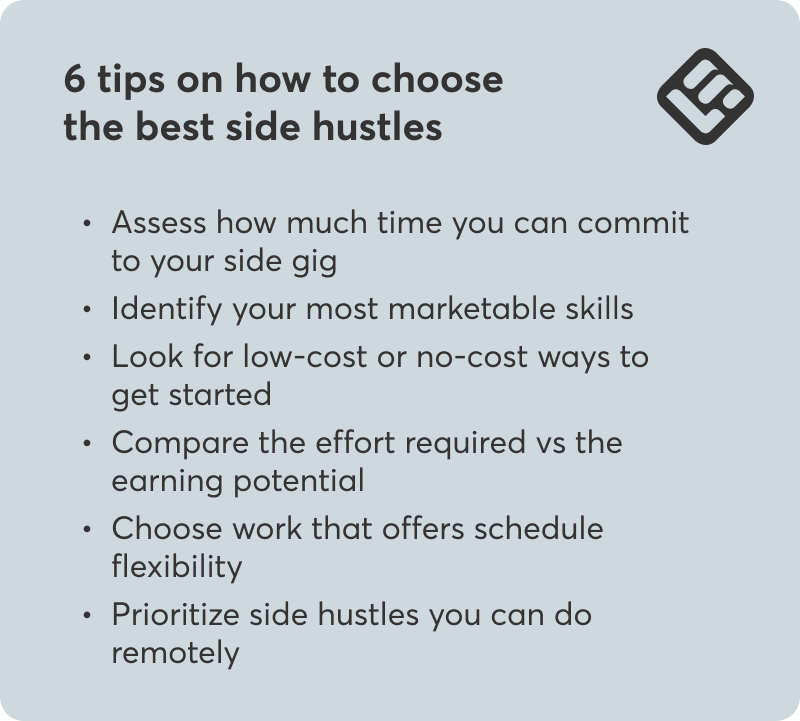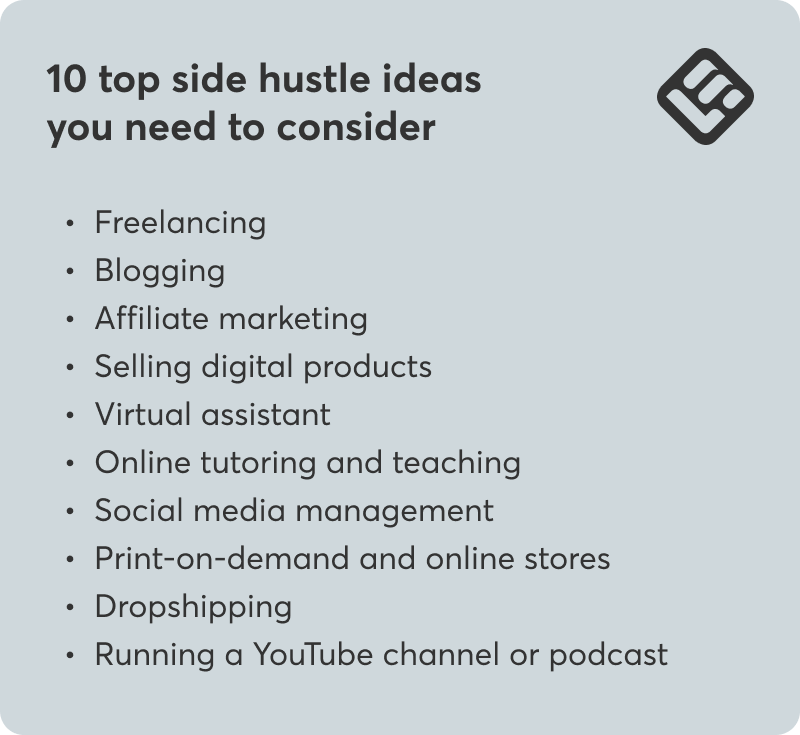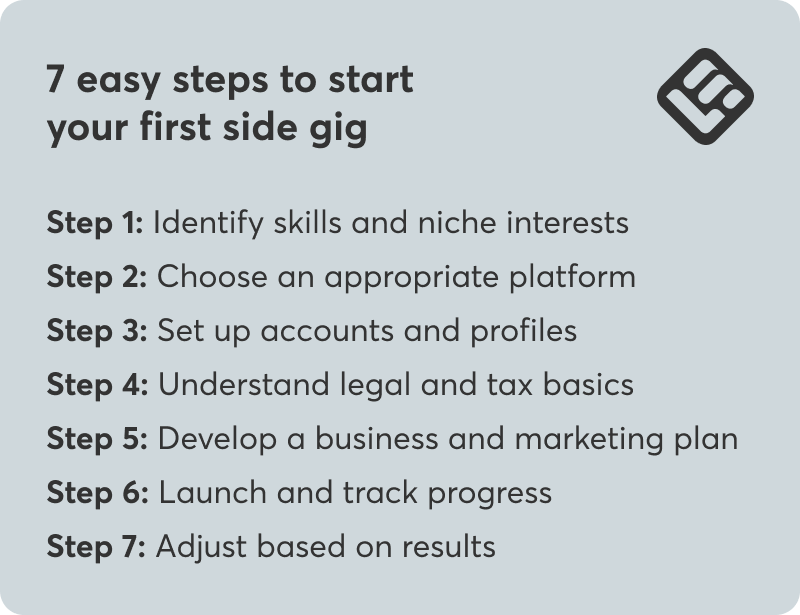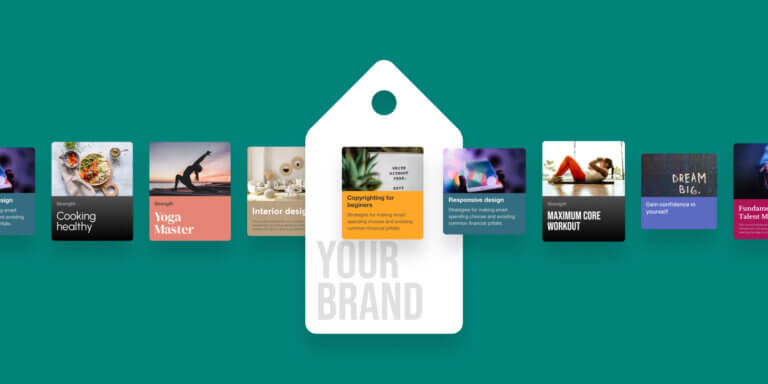Table of Contents
Ask a room full of people, “Who has a side hustle?” and nearly 40% [1] of them will raise a hand. Then ask how many of them ever answer surveys or sell on platforms like eBay to make a little extra cash, and that number of hands up jumps to almost 93%, according to Side Hustle Nation.
Even I had a side hustle. I turned into my full-time job, and then guess what? I started another one. The gig economy is here to stay, and if you’re ready to get in on the action—or you’re like me and always looking for your next side gig, I’ve got you covered.
I put together a list of the 51 best side hustle ideas to make money online. And since I’ve done this before, I’ve also included some tips to help you get started. Speaking of starting, I recommend scanning this table to get a sense of what’s out there before truly diving in.
*The earning potentials listed are an average range. Actual extra income will depend on your expertise and niche, and market demand.
What is a side hustle?
A side hustle is a way to earn money that isn’t your full-time job. It can become your full-time job, like mine did, but by definition, it functions as a bit of side work that brings in extra cash to supplement your income.
Side hustle, side gig, side business, moonlighting—whatever you want to call it—working outside of your 9-5 job has become common worldwide. In 2025 alone, the side gig industry hit $582.2 billion, and it’s expected to grow.
Why aren’t people just sticking to their traditional jobs, you ask? Economic uncertainty and disappointment with conventional employment are reasons for some. In fact, 20% of people who side hustle are working towards eventually replacing their actual work.
Pros and cons of starting side hustles from home
My work now started as a side hustle from home, so I know the ins and outs and the good and the bad. I used to do my planning during my commute and put things into action in the evenings and on weekends. I started during COVID, so I didn’t miss out on many social things, and I felt like I had the time and energy to get my gig off the ground.
That being said, while I had a lot of freedom with my time, it was tricky going at it alone. I didn’t know anyone who had started a gig like mine, so I didn’t have someone to ask for help. Luckily, the online world is chock full of free resources, and let me tell you, I devoured as many as I could.
Here are some of the biggest pros and cons of starting your side hustle from home.
| Pros | Cons |
| Flexible schedule and no commute | It might feel isolating working alone |
| Extra money without quitting your day job | Balancing the work with your main job might feel tiring, and you might miss out on social things |
| You can test ideas with low risk | Not a lot of structure or external accountability, no one to go to with questions or for help |
| You get to make all the decisions, it’s all yours | Decision fatigue, as it can be hard to know what to do and not to do |
| Free tools can help you get started | There might be a steep learning curve, and you’ll likely make mistakes before figuring everything out—but that’s ok |
What makes good side hustle ideas?
The best side hustle ideas have room to grow, but don’t need to start big. It’s likely something you’re either interested in already or good at, but again, it doesn’t have to be. Before committing, make sure to thoroughly research your business idea to understand its potential and any legal or marketing considerations.
Pick something flexible time-wise, so you can work on it when you’re free without it limiting when you are and aren’t available for regular life things. Also, go for something that doesn’t need a pile of gear or huge upfront costs.
A good side hustle idea is:
You don’t have to check all of these boxes necessarily, but hitting as many as possible will help set you up for a side hustle that is sustainable. And one you actually like to do.
How to choose the best side hustles to make extra money from home
As you go through my list of ways to make money online, filter out the ones that won’t work for you. These quick checks will help you narrow it down to the ideas that match your lifestyle and actually stand a chance of sticking.
Be sure to consider startup costs as well, since even low-cost side hustles may require some investment or financial planning to begin with.

Assess how much time you can realistically commit to your side gig
Ask yourself where you can find time to dedicate to your side hustle and if, realistically, you can keep it up over time. There’s no right or wrong answer—what’s great about side hustles is that they can be designed to fit around your schedule. But you do want to make sure you choose a hustle where the demands don’t outweigh the time you can commit.
Identify your most marketable skills
This is exactly how I pinpointed my side hustle. People have always come to me for help with their writing: friends, family members, acquaintances with small businesses. So I thought, ok, why not start charging for this?
I doubted at first whether it would work, but a friend pointed out that I didn’t need to be the absolute best in the whole world, just better than the person who was willing to pay me for it. So, think about what you’re good at, what do people come to you for? If it helps, think back on previous jobs or hobbies to find what that sellable skill could be.
Look for low-cost or no-cost ways to get started
I started my side biz completely for free. How? The internet is full of free resources. Tools with free trials, tools that are just totally free, free networking opportunities, you name it. Keeping things low-cost helps you reduce risk and keep more of the profits.
You can read more about tools after the list of the best side hustles, but a few to consider are Canva, Notion, Etsy, Gumroad, and YouTube.
Compare the effort required versus the earning potential
This is a big one. You may have an incredible idea that sounds like lots of fun, but how lucrative is it? In addition to not dumping a lot of money upfront into your side biz, you also want to be careful with your time. If the effort doesn’t balance well with your earning potential, without the reward for your work, you can burn out easily and are more likely to quit.
Choose work that offers schedule flexibility
Since this is your side hustle, you want to make sure the work stays flexible. The last thing you want is a gig that pulls your attention and time away from other important or fun things at the last minute. Is it something that you can pick away at in your free time?
Prioritize side hustles you can do remotely
If you’re going to squeeze a side hustle into an already full life, make it one you can do from anywhere: a cafe, your kitchen table, your bed. The less time you spend getting somewhere or setting things up, the more time you can spend working and earning. Remote-friendly gigs are also easier to keep going when your schedule changes or life gets messy.
51 top side hustle ideas worth considering
You know what to look for, you’ve thought about your time constraints and skills, which means you’re ready for my monster list of 51 top side hustle ideas. Have a look, keep your parameters in mind, and hopefully, get inspired.

1. Freelancing
As a freelancer, you offer your skills to individuals or businesses on a per-project or contract basis. You set your own rates and hours, and typically focus on one niche offering like writing copy for financial websites or graphic design for software startups.
2. Blogging
This is my side hustle #2. You write content on a specific niche or topic and build an audience over time. The cool thing about blogging is that you can bring in income in a variety of ways. You can make money as an elearning affiliate, sell courses or downloadable resources, or have sponsorships.
3. Affiliate marketing
Speaking of affiliate marketing, it doesn’t just need to link to blogging. How do you think all those influencers make their money? You can use affiliate marketing through a blog, through social media, or even through an email list.
4. Selling digital products
This includes selling things like templates or design assets. You make them once and sell them over and over. Platforms like Gumroad or Shopify make hosting easy. My favorite perks? Zero inventory and instant delivery to customers make it great for long-term passive income.
5. Virtual assistant
I once met a woman in Thailand who turned her virtual assistant side hustle into complete financial independence. And used it to travel the world. VAs help business owners stay organized by handling email or admin work, but tasks vary depending on the client. It’s a solid gig for detail-oriented people, and one that you can do from anywhere.
6. Online tutoring and teaching
With a tutoring business, you teach academic subjects or skills like coding or languages. You can work for a platform or go independent. Sessions are typically 1-on-1 or small groups. If you want to keep this flexible and scalable, you can create your own courses.
7. Social media management
Nothing beats hobbies that make money. Social media is a necessary component to successful businesses, but not everyone has the head or the time for it. If you’re up on trends and enjoy using social media, you likely already have or can learn the skills needed to manage someone else’s.
8. Print-on-demand and online stores
With print-on-demand, you design items like shirts or mugs that only get made when someone buys. No inventory or shipping required. Services like Printful or TeeSpring do the fulfillment while you focus on design and promotion.
9. Dropshipping
Dropshipping is another side hustle model that deals in physical goods but doesn’t require you to have them. It’s low risk, but pretty competitive nowadays. I recommend picking a very specific niche and focusing on that. If you couple it with a blog or email list, you can curate your audience to sell to.
10. Running a YouTube channel or podcast
To make money on YouTube, you can create content around anything, from reviews to storytelling. The money comes from ads, sponsors, affiliate links, or merch. It can take time to build an audience, but it pays off with consistent effort.
11. Testing apps and websites
Companies pay real people to test out their websites or apps and give feedback. It doesn’t pay a ton per test, but it’s straightforward and flexible. This type of side hustle works well if you don’t want to launch your own thing but still want to earn a little extra from time to time.
12. Taking online surveys
Similar to testing apps and websites, taking online surveys doesn’t pay a lot. But you can hop on sites when it suits you for a little extra cash, meaning it’s a nice way to earn a bit with pretty low effort.
13. Ecommerce re-selling (eBay, Amazon, etc.)
Buy low, sell high. You can flip thrifted items or clearance finds on platforms like eBay, Amazon, or Facebook Marketplace. Some people turn this into a full-time income, but it also works well as a weekend side hustle. You’ll need space for inventory and some patience for shipping.
14. Influencer marketing
If you’ve built a loyal niche audience, brands will pay to access it, even if it’s small. Your income comes through sponsored posts, affiliate links, or content partnerships. To be successful, focus on engagement over follower count.
15. Remote bookkeeping/professional services
A friend of mine made this her side hustle, and if you have a background in finance or accounting, you can too. Small businesses often can’t afford full-time staff, but they do need someone to keep things running. You can offer monthly packages or hourly services. It’s low overhead and high trust, and client retention tends to be strong.
16. Resume and cover letter writing
You don’t necessarily need a background in HR or hiring for this online business model, but it can help. Coupled with strong writing skills and a knack for extracting key details from your client’s work histories, this can be an excellent side hustle. Niche down to the corporate or C-suite level, and you can charge a lot for it, too.
17. Voiceover work
If you’ve got a clear voice and decent mic setup, you can find paid gigs for ads, explainer videos, audiobooks, or animations. Sites like Voices.com or Fiverr are good starting points. You’ll need to create a demo reel and maybe learn a bit of audio editing, but nothing too intensive to get started.
18. Online transcription
This is a simple gig, but it can take up some time. Essentially, you listen to audio files and type what you hear, word for word. It usually pays by the audio minute, so the faster and more accurate you are, the more you stand to earn. And yes, they do have AI for this now, but in my experience, it still isn’t quite as accurate as a human.
19. Data entry jobs
This is one of the best side hustles since it doesn’t require a high-level skillset, but you do need to care about accuracy and precision. With this gig, you’ll be entering or formatting information for companies that don’t want to do it themselves. It’s not glamorous, but it can be a great source of long-term side income.
20. Proofreading and editing
This was my first side hustle. If you’re that person who gets distracted by typos or just gets pained by a paragraph that could have been written a tiny bit better, this could be a good one for you, too. If you speak multiple languages, I’d start by looking for companies that market in multiple regions and put those skills to use.
21. Podcast editing services
If you don’t want to start your own podcast, you can still make money editing someone else’s. If you’re familiar with tools like Audacity or Descript, you’re already ahead of the game. Bonus: This is one of those services that can turn into retainer work fast.
22. Self-publishing ebooks
These ebooks don’t have to be nonfiction masterpieces. In fact, guides, how-tos, and bite-sized topics that offer practical advice usually sell best. The catch with this one is that you not only have to write the ebook, but you also have to have an audience willing to buy it. In my opinion, it’s best combined with something like blogging or influencing.
23. Creating and selling Notion templates
I love Notion, but I can’t be bothered to spend the time setting it up. I know I’m not the only one, cause a quick perusal of Notion’s site will yield hundreds if not thousands of templates for people like me. The market isn’t necessarily saturated, though, so if you’ve got the know-how and some creative ideas, Notion templates could be the hustle for you.
24. Course creation on online platforms
Ah, course creation. A little bit of setup, and courses can keep selling and selling and selling. Start with something people already ask you about—Excel tips, email marketing, watercolor painting, really anything. You can sell courses on Amazon, but with an online platform like an LMS supporting it, it’s scalable and hands-off once it’s live.
25. Creating paid newsletters or email courses
A friend of mine started small with a daily newsletter of job openings. Over time, he grew it to include sponsorships and affiliate marketing, and eventually, he was able to sell it for a tidy sum. To build a newsletter side hustle, start small with something specific and build trust with your audience by consistently offering valuable content.
26. Stock photography or video contributions
All these online businesses? They need images for their sites, social media, newsletters, and downloadable resources. Where do they get it? Unless they’ve got the skills or an in-house photographer, they use stock photography sites. If you’ve got skills with photography and editing, why not turn that into a small side hustle?
27. Selling templates or printables on Etsy
Notion isn’t the only place for selling templates. Etsy is another great site for that. If you can design it in Canva, you can sell it as a printable. Once your shop is set up, your main job becomes SEO and marketing. This is one of the easiest digital product gigs to break into.
28. Subscription-based communities (like Patreon)
If you’re already building a niche audience, you can offer exclusive content through platforms like Patreon or even Discord. This would be behind-the-scenes content, early access, or Q&As that are offered exclusively for your subscribers.
29. Email marketing services
Small businesses need digital marketing services like newsletters, abandoned cart emails, welcome sequences—and most don’t want to write or manage them. If you know your way around Mailchimp or ConvertKit, you can offer this as a service. This side hustle requires some experience in copywriting and marketing, but if you have those, it can be a well-paying one.
30. SEO consulting
Businesses need help with SEO to help their sites show up in searches. With AI a factor now, they need help with generative engine optimization (GEO), too. You can offer audits, coaching, or implementation, depending on your level of expertise. Local businesses are often overlooked and make great first clients.
31. Product listing optimization for ecommerce
This is a bit similar to other digital marketing services like SEO optimization, but it’s specifically for ecommerce. Those product pages you see on online stores? They are tailored to show up in buyers’ search results, and companies are more than willing to pay top talent to do that tailoring.
32. Selling website themes or plugins
If you’re a developer or designer, you can build and sell custom themes or plugins for sites. I paid a steep but fair price for my WordPress plugins because they were exactly what I needed for my blog, and I didn’t have the know-how to make them myself. Once created, they can sell repeatedly with minimal ongoing maintenance from you.
33. Coding or website fixes
People will pay a lot for you to fix or troubleshoot bugs on their sites. Just check gig platforms like UpWork and you’ll see plenty of small, one-off requests. This is a solid hustle if you’re good at coding and want quick, low-commitment projects.
34. Language tutoring
I know several people who tutor in their spare hours as a side hustle. You can do this in any language you are fluent in, though some platforms might expect you to be a native speaker to tutor with them. If you want to go solo, you can set up courses and 1:1 tutoring using an LMS to schedule sessions around your other commitments.
35. Career coaching
I recently onboarded a new client who is a career coach. She built her coaching as a side hustle in her spare time from her regular job and is currently scaling it to grow. If you naturally find yourself mentoring others with their careers, you can start out on platforms like MentorCruise and build your portfolio and client base from there.
36. Test prep coaching
SAT, GRE, LSAT, MCAT—whatever your test of choice, people will pay for help with it. If you’ve scored well and know how to teach the strategy behind it, this is a great niche. Rates tend to be higher than general tutoring as well. This only works, of course, if you have either taken the course itself or have experience teaching its subject matter.
37. Remote tech support
Good with tech and patient with people? There’s a market for helping non-tech-savvy users with devices or software. You can find work through job boards or set up shop with your own website, where you can offer packages to small businesses.
38. Website or UX audits
UX has to do with a user’s experience while they are on a website, and businesses will pay for people to test theirs out. You explore the site and identify what works and what doesn’t, and suggest improvements. If you have the skills, you can offer to implement those improvements too, for an added fee, of course.
39. Moderating Discord or Facebook groups
Online communities need people to answer questions and keep things running smoothly. If you’re already active in a niche group, reach out to the admin to see if they might be hiring or open to the idea. This can also lead to community manager roles if you’re good at it.
40. Chatbot training or moderation
AI tools need humans behind the scenes to test and train chat interactions. Some jobs involve writing prompts or responses, while others require reviewing outputs for accuracy or tone. You might want to check it out if you’re interested in AI and have some linguistics, tech, or writing experience.
41. Custom digital art commissions
You can do a lot with this one if you have some artistic skills. People look for custom drawings of pets or illustrations for their books. I have a friend who even creates animations and visuals for YouTube videos. For this one, creating a portfolio of your work can take you far when first getting started.
42. Pet sitting or virtual pet consults
Ok, this one isn’t totally online, but it uses online tools to get you set up. Apps like Rover let you offer pet walking, sitting, or even drop-in visits as a legit side hustle. If you have experience in training animals or veterinary work, you can also try virtual pet coaching to help pet owners with everything from training to behavioral issues.
43. Selling handmade goods
This one requires some physical merchandise, but if you’re already crafting and creating, it can be a nice way to turn that hobby into some extra money. You can sell your goods through Etsy or Instagram, or you can create your own website and use Shopify to support sales.
44. Renting out equipment online
Got a camera, power tools, projector, or even camping gear sitting around? You can rent those items out locally on platforms like Fat Llama or PeerRenters. It’s a good way to earn passive income from stuff you already own.
45. Translation services
People say this a lot, but it’s true: we live in a globalized world. If you speak more than one language fluently, your skills are in demand. You can work through an agency for this or look for work in an industry you’re already familiar with. If you want to start small, you can always try freelancing platforms like UpWork and Fiverr, too.
46. Legal document review (if qualified)
You need to be qualified and licensed for this one, but if you are, you can make some good money offering to review all sorts of legal documents. These could be leases or business contracts, anything where your clients would benefit from a trained legal eye.
47. Creating digital planners
Love organization? I mean, like, really love it? Put it to work by building digital planners people can use on tablets or apps like GoodNotes. These can range from minimalist daily planners to niche systems like wedding planning or fitness tracking. If you’ve got an eye for design and a brain for structure, this is a great one-and-done product to sell.
48. Offering virtual workshops or webinars
For this one, you host live sessions online where you teach something you know. Simple. It could be a one-off class or part of a short series, but make sure it’s something you’re good at and will enjoy teaching to others. These work best if you already have a small audience or email list to promote to, but it’s not absolutely necessary for getting started.
49. Selling digital flashcards or study tools
Back to the best side hustles ideas that involve studying or tutoring—if you want to be totally hands-off, you can always create digital flashcards or study tools instead of live tutoring or workshops. Again, the topics you choose should be ones that you are proficient in or at least can be checked for accuracy and correctness before selling.
50. Writing educational blog posts or tutorials
If you’ve ever Googled “how to do XYZ in Excel” and landed on a post that made you want to scream, this is your moment (this was me, yesterday). You can publish on your own blog or get paid to write for others in your niche. It’s especially effective if you’re already doing this stuff at work or in your own business.
51. Creating ad copy or landing pages
Not every writer can write copy, and that’s what makes creating compelling ad copy or landing pages so valuable. As a copywriter, you’re convincing someone to buy or sign up for something, like handing over their email, with your words. If you understand branding and buyer personas, start a side hustle writing copy.
Essential tools and platforms for working in side jobs from home
There are literally hundreds of tools and platforms designed to help you start a side hustle. My take? Simplicity is best. Choose a few, well-made tools that serve multiple functions. This will give you the resources you need without getting bogged down by bouncing back and forth between software to software.
My top picks for a curated toolbox for those working in side jobs from home:
If you’re creating and selling online courses, LearnWorlds is one of the best options for course platforms. Its course builder is intuitive and makes it easy to add interactive elements so your content stands out.
Sites like Upwork, Fiverr, and Contra connect you with clients quickly. They’re also a good way to test your pricing and offers. I used Upwork to build my portfolio.
Buffer, Later, and Metricool help you schedule posts and track performance without logging in and out of multiple platforms every day.
QuickBooks, Wave, and Fiverr Workspace (which I personally use) keep your income and expenses organized in one place. They are also super handy and necessary when tax season rolls around.
A tip from someone with a real side hustle:
Caleb Johnstone, SEO Director at Paperstack
Easy steps to start your first side gig
Hopefully, at this point, you’re feeling pretty excited to start a side gig. That’s good. When I’d finally figured out what and how I wanted to do mine, I couldn’t wait to dive in. One thing I want to stress, though, is the importance of easing yourself into it.
Being methodical and thoughtful during the set-up process and early days will set you up for success and growth. Follow these steps for a good foundation.

1. Identify skills and niche interests
Gonna start a side hustle? Start with what you know or enjoy, and think about where those overlap with something people are willing to pay for.
2. Choose an appropriate platform
Pick the one that puts you in front of your ideal audience, whether that’s a marketplace like Etsy or a learning management system like LearnWorlds.
3. Set up accounts and profiles
Make these clear and professional. Use consistent branding if you have it (and use Canva to make it if you don’t). Focus on the value you offer, not just what you’re selling, and include examples of your work if you have them.
4. Understand legal and tax basics
It’s all fun and games until tax season rolls around and you’re sifting through a disorganized mess to find what you need. Keep track of income and expenses from the start. Before you start a side gig, know what’s required where you live so you can stay compliant.
5. Develop a business and marketing plan
Do this before you start your side hustle: outline your offer, pricing, and how you’ll reach customers. Get it down on paper and use it to guide you. Feel free to adjust it as you test and iterate.
6. Launch and track progress
First, identify your key metrics. These could be sales, sign-ups, click-through rates, or free trials. Don’t worry about being perfect when you launch, trust me, no one is, and track these metrics to figure out what’s working for you and change what isn’t.
7. Adjust based on results
Once you have data, you can make changes based on the facts. If one product or service gets more interest, lean into it. If a marketing channel isn’t delivering, try a new one. I’m constantly tweaking things based on direct data and feedback. It really helps.
Online side hustles to avoid (and why)
It might be hard to know right away if a side hustle is right for you. Sometimes you just have to give it a shot. However, there are some online side hustles that you should always avoid.
Avoid side hustles like:
Some of these, like MLMs, tend to rely heavily on recruiting instead of selling something valuable. Others require a level of expertise you can’t shortcut, or pay so little they aren’t worth it.
If you’re not sure, try researching the organization or platform to see what other users say. When in doubt, I say trust your gut. If it seems too good to be true, it probably is.
How to make extra income while working full-time
The best way to make extra income while working full-time is to start a side hustle that will actually work for you. Be realistic about the time and energy you have to put into a side hustle.
After picking a few that interest you from my list, do some deeper research to figure out what the time commitments are like for each one.
Ideally, start with a side hustle idea that hits these key areas:
Where side careers are heading in 2025
This list of 51 side hustles isn’t fixed, and new opportunities to start a side hustle are popping up all the time.
In 2025, emerging trends include:
Translated into gigs, this could look like:
The opportunities for flexible, digital-first work are only getting bigger.
Alex Alexakis, Founder at Pixel Chefs, adds:
“In the next few years, I expect three online income streams to grow quickly: knowledge products, niche e-commerce, and AI-enabled services. Knowledge products, including courses, workshops, and templates, will continue to grow as professionals package and build products from their expertise, a growth tactic especially enabled with the proliferation of micro-credentials and self-paced learning options.”
💡Read also: The certification goldmine: how to monetize micro-credentials online
Build an online course and make extra money from home with LearnWorlds
Online courses are one of the best ways to package your expertise into a side hustle product you can sell over and over. Platforms like LearnWorlds make it possible to create interactive, polished courses and then sell them easily with the help of automation.
Courses can work as a side biz or as part of a larger strategy to earn money.
Ready to find out how it can help you start a side hustle? Explore LearnWorlds’ solutions or start a free trial.
Sources

Ciera Lamb
Ciera is a freelance content writer and editor connecting companies with their ideal audiences through blog articles and other online content. She approaches her writing with curiosity and research and enjoys the ever-present learning that comes with being a content writer. She is also an avid scuba diver, an aspiring Dutch speaker, and lover of all things nature.
FAQ
Everything you have ever wondered, but were too afraid to ask...




